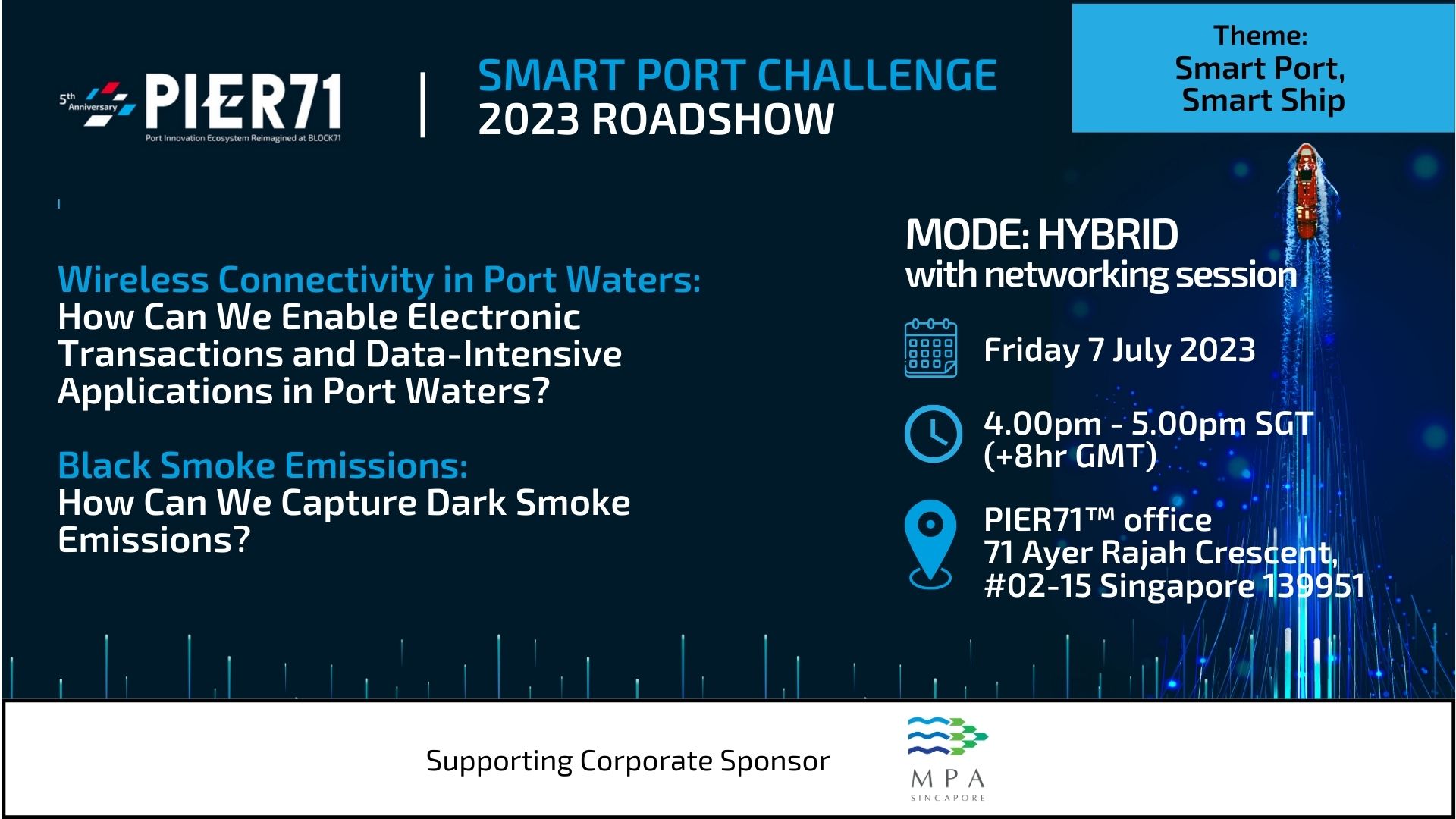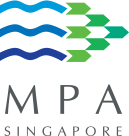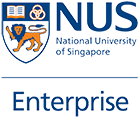SPC2023 Roadshow with MPA on Wireless Connectivity & Capturing Black Smoke Emissions

Smart Port Challenge (SPC) is an annual innovation competition to find the best ideas and solutions from technology start-ups to address challenges, or innovation opportunities, put forth by maritime corporates in Singapore.
This will be a hybrid event, held from the PIER71TM office in Singapore. If you have signed up for the In-Person event – so do stay for the networking with supporting corporate sponsors held after the event.
Register for in-person event with networking here.
Register for online event.
Innovation Opportunity #1:
The Maritime and Port Authority of Singapore (MPA) is driving the digital transformation of the maritime industry and positioning our Hub Port and International Maritime Centre for the future.
Singapore has one of the most efficient and reliable ports in the world, but certain port and harbour craft operations and processes are still labour intensive, and paper based. These could be due to legacy practices, lack of technological solutions, or international/ local regulatory issues. Without efficient, reliable, and secure broadband wireless connectivity in our port waters, many of these port operations will not be able to be further automated or performed electronically. Immediate use cases include digital bunkering, digital ship supplies, remote pilotage and drones operations.
MPA is prepared to provide regulatory sandbox environment for technology solutions that require exemptions to existing regulatory restrictions where safeguards are in place.
Challenges
Conventional wireless communications such as Satellite Communication (Satcomm), 4G (and 5G progressively in 2024 and 2025) and AIS have the following limitations:
- Line of sight (LOS) issues, e.g., service provider’s harbour craft (bunker supplier, ship supplies provider, towage provider) communication signals can be blocked by another bigger serviced ship.
- 4G/5G has limited range and reliability in port water environment
- AIS has limited bandwidth and real-time capability to deliver content rich applications.
- Very few locations in our port waters for installation of base station.
- Satcomm has much higher costs (both CAPEX and OPEX) and poorer latency than 4G/5G communication, where the low latency is necessary for certain applications e.g., remote pilotage. Moreover, most of the harbour craft does not have satellite communication equipment installed.
Desired Outcomes
The proposed innovation should provide a holistic way for systems, applications, machine and personnel at sea to carry out electronic transactions, regulatory submissions, workflows, signatures, documentations, and forms filling efficiently, reliably and securely between service provider vessels and service consumer ships in our port waters. Overhead costs, new installation or modification should be kept minimal especially for ocean going ships which operate globally and adopt global standards.
Full details on the Innovation Opportunity can be found here: https://pier71.sg/spc/wireless-broadband-connectivity-in-port-waters-2/
Innovation Opportunity #2
Ships emit black smoke due to incomplete combustion of fuel, which results in the release of small carbon particles harmful to human health and the environment. The quality of fuel used by ships, engine performance, and operational conditions affect black smoke emission. The International Maritime Organization has set a limit on the sulphur content of marine fuel to prevent black smoke emission due to high sulphur content. Proper engine maintenance, tuning, and optimizing operational conditions can significantly reduce black smoke emission, which is essential to protect human health and the environment.
Challenge
To capture dark smoke emission and assist a MPA officer in deciding if an infringement report is to be made for an offence under Port Regulations 66 – “No person may cause smoke, soot, ash or grit to be emitted from a vessel in such quantity or density as may, in the opinion of the Authority, be a nuisance.”
Current MARPOL requirement on smoke emission
The international standards on smoke emissions are based on Annex VI of the MARPOL regulations that addresses air pollution prevention requirements from ships. In 2019, MPA has released a guide for ships calling to the port, with information on prohibitions of sulphur content found in ship fuel.
MPA’s requirements on smoke emission
Regulation on smoke emissionUnder Regulation 66 of Port Regulations, a port inspector will record the smoke emission for 15 minutes and compare the smoke colour against the Ringelmann chart to determine if exceeds Ringelmann 2 before raising an infringement report.
Measures taken by MPA
To curb the emissions of dark smoke, MPA has been taking a balanced approach by firstly educating the shipping community of the root causes and publishing guidelines to reduce emissions. Enforcement actions will be taken for offences.
Challenges
- Limitations of CCTV cameras. CCTV cameras are unable to identify the vessel which may be blocked by other vessels along the line of sight or is anchored/moving in front of a larger ship with a darker hull or superstructure fitting.
- Monitoring of black smoke emission during night hours. Currently, enforcement of black smoke emission is limited to daylight hours only due to visibility issues at night.
- Poor weather conditions: a) Rain/haze etc – Poor visibility and smoke dissipation affects the accuracy of the shades. b) Cloudy skies – A reduction in colour contrast due to dark clouds in the background poses challenges in shade identification.
Desired Outcome
Solutions should ideally:
– Identify and correlate the vessel emitting black smoke with its AIS information– Provide an accurate assessment on the shade of the black smoke based on the Ringelmann Chart
– Capture and manage evidence, including video clips of the vessel during emission– Incorporate a system prompt with an evaluation made based on the default criteria and evidence, so that officers can decide if an infringement report is to be made.– Alert officers when a vessel is emitting black smoke
Full details on the Innovation Opportunity can be found here: https://pier71.sg/spc/black-smoke-emission-how-can-we-capture-dark-smoke-emission/
Hear from the corporate speakers and engage with them with your queries to spur your ideation towards a solution for this Innovation Opportunity.
For more about PIER71TM: www.pier71.sg
Smart Port Challenge 2023: https://pier71.sg/smart-port-challenge/
Proposal Submission by 31 July 2023, 5pm (SGT) to: https://pier71.typeform.com/to/bkwkN6ki


